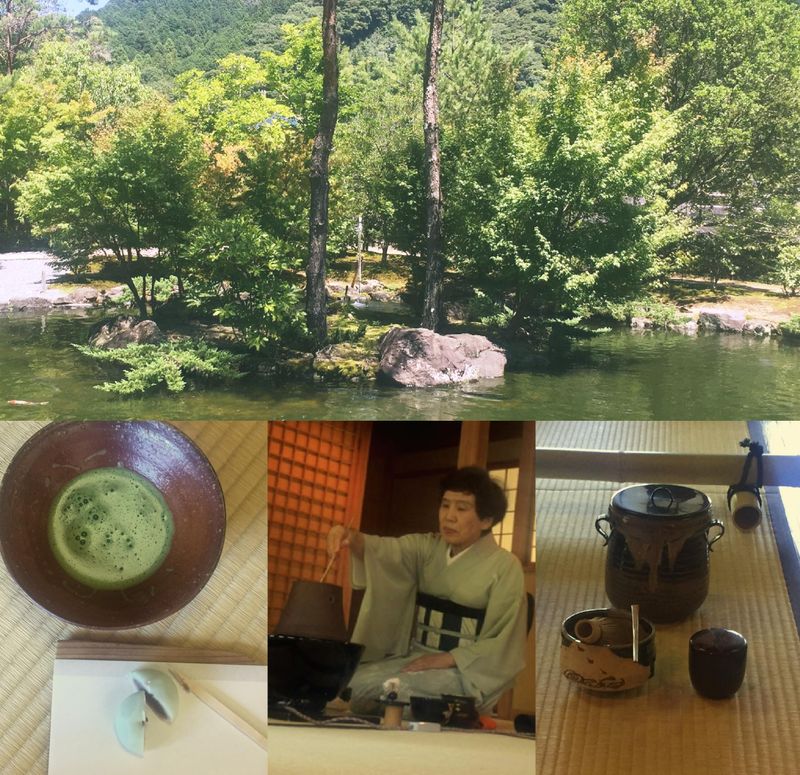Sep 23, 2017
茶道 ... The Japanese Tea Ceremony
Sadou, or chadou, is the Japanese term for the formal practice of making and drinking macha, (powdered Japanese green tea). The Japanese word sadou is comprised of two kanji, the first kanji, 茶, meaning "tea" is pronounced cha or sa, and the second kanji, 道, meaning “a path” or “a teaching” or, as I like to think of it myself, “a discipline” is pronounced dou. This is an example of how concise and expressive the Japanese written language can be; where two, not-so-difficult characters, immediately convey that this word, sadou, is not just about making or drinking tea but that it is about much more than that.
Recently, I was lucky enough to be included in a trip to Hyogetsu-tei, a teahouse in Gyokuro-no-Sato, in Shizuoka prefecture. Like most teahouses in Japan, Hyogetsu-tei is surrounded by nature with a pond visible from the tearoom; this tranquil setting is a key component of the Japanese tea ceremony. Hyogetsu-tei's tearoom is also traditional; it has tatami flooring (woven straw mat), and an alcove where art and flowers are displayed, and shoji (paper sliding doors) adorning the windows. As is customary upon entering a teahouse we remove our shoes and allow the host to guide us to the tearoom and to our seats. Traditionally people wear kimono to a formal tea ceremony but this occasion is a more relaxed affair and my casual street clothes are acceptable but, of course, our host is wearing a kimono.
There are two types of tea that can be served at sadou; usucha (thin tea) and koicha (thick tea). Today, our host will make and serve us usucha. The macha and hot water are added to a beautifully, handcrafted tea bowl and blended together with a whisk made from bamboo. We are each given wagashi (a traditional Japanese sweet) which we cut into small pieces so as to savor each bite . The usucha is served with the ornate side of the bowl facing us. Our host shows us how to correctly pick up the bowl with the right hand and place it in the left palm. Then, before drinking the usucha she tells us that we must rotate the bowl clockwise and drink from the less ornate side to allow the other guests to admire its craftsmanship and originality. We taste our wagashi then sip from the tea bowl, the contrast of the sweet wagashi and the slightly bitter usucha enhancing the taste of both. Once we have finished it is important to "very-obviously" admire the tea bowl itself, turning it from side to side, while holding it carefully near the floor so it does not break if it somehow falls. This is an expression of consideration to both the host and the bowl's craftsman.

As non-Japanese we have many questions as we are often nervous about making mistakes or insulting our hosts through our lack of knowledge of customs and culture. Our host answers both graciously and enthusiastically; delighted to share her knowledge and expertise with us. Then she and her staff slip into the background and allow us to freely admire the art and bathe in the tranquility of our beautiful setting.
Thank you to City Cost (Shizuoka Green Tea) for the opportunity to visit Gyokuro-no-Sato, and thanks to The World Green Tea Association for their hospitality and generosity.
The following links provide some more detailed information:
Basic Information for Gyokuro-no-Sato (玉露の里)
Basic information for Hyogetsu Teahouse
Fujieda City information for Gyokuro-no-Sato (玉露の里)
Facebook page for Gyokuro-no-Sato (玉露の里)
This post is a special tea blog report, part of our Shizuoka Green Tea Guide, and a chance through City-Cost for bloggers in Japan to engage in new “Japan” experiences about which to create posts.
Helping other non-Japanese stay positive in this sometimes-tough-to-survive-in but amazing country.



2 Comments
BigfamJapan
on Sep 23
This is a great concise easy to follow summary of the green tea ceremony, which if truth be told was confusing me something terrible until I read this!!
LovingJapan
on Oct 19
@Saitama Thanks Saitama